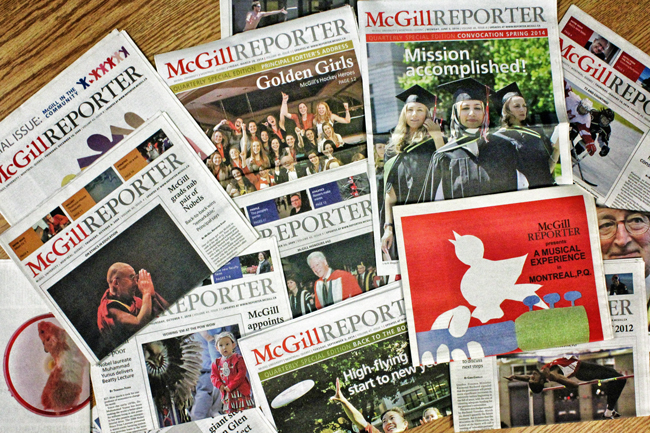
By Doug Sweet
On Friday, May 29, 2015, The McGill Reporter will publish our final print edition, featuring coverage of Spring Convocation and other University events. From that point on, we’ll be online only.
This is part of the evolution of The Reporter, which began publishing in 1968 as a weekly, and moved to fortnightly publication some years later, before becoming a primarily online publication, with a quarterly print product, in the fall of 2012.
But that doesn’t mean McGillians will be starved for information about what’s happening at the University. In recent years, readership of The Reporter’s website has climbed steadily, from about 15,000 page views a month three years ago to nearly 50,000 page views a month today. And, given the constant churn of content, far more stories are going up on the website every month than was achieved “in the old days” of fortnightly publication. At the same time, we had been reducing our print run and it was becoming evident from the number of copies left in the racks that people preferred online delivery to print.
In the more than 1,400,000 page views we’ve had since November 2012, we’ve had some notably enormous stories in recent years online, including a piece about some remarkable brain mapping (45,000-plus page views), a story about McGill’s Hult Prize winners (20,000-plus) and two stories have hit 12,000 (a piece on global warming and one on our latest Rhodes scholars).
“We’re telling more stories to more people,” said Olivier Marcil, Vice-Principal (Communications and External Relations), whose department produces The Reporter. “I am very happy with the steady, sometimes dramatic, increases we’ve seen in online readership and I think that underlines the fact that we are moving with the times and delivering news about McGill in a format people are comfortable with and prefer.
“We will save more in terms of print costs, continue to reduce our ecological footprint and will be able to make improvements to the website that should make it even more attractive to our readers – and advertisers – in the months to come.”
Reporter Editor in Chief Neale McDevitt said he’s been surprised by the support we’ve had from readers in the transition to online-only publication.
“I thought we’d hear a lot more from readers who preferred print to online, but the fact is we only had a few complaints. I thought I’d be one of those who missed print, because I’ve worked in print publications for decades, but I was pleasantly surprised to get even more of a kick watching the number of readers go up and up and up.
“It’s really a thrill to know you’re reaching so many more people, more frequently, with more content. And if we weren’t delivering the kind of content people are looking for, I don’t think our numbers would have climbed so rapidly.”
The Reporter’s change to an online-only format is part of a growing trend across North American college and university campuses, as documented by such major journalistic organizations as the Poynter Institute. “A growing number of papers are cutting or considering cutting the number of print editions they publish each week or month,” Poynter reported on its website last fall. “Others are trimming their page sizes or reducing the number of copies or pages produced for each issue.
Along with the what’snew@mcgill and what’snewstudents@mcgill electronic newsletters, plus The Reporter’s Twitter feed, Reporter stories are pushed out to a wide audience, which is reflected in an uptick in website hits each time those newsletters go out, McDevitt said.
And The Reporter’s website has become the go-to place for up-to-the-minute news about emergencies on campus.
Photo galleries, including those from major events like Convocation, major stories about administrative or budgetary matters, big research stories and sports coverage are among the more popular items on the website. The ability to include video was unimaginable in the print era, and there’s also more opportunity for comment and conversations amongst readers via the website.
-30-
